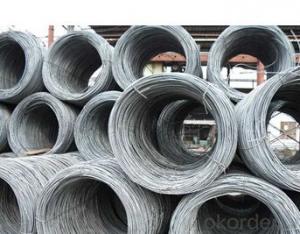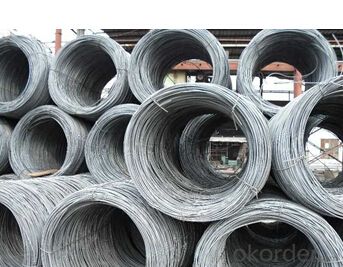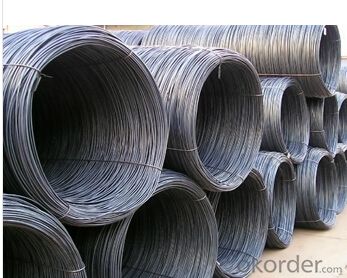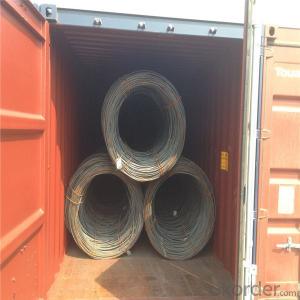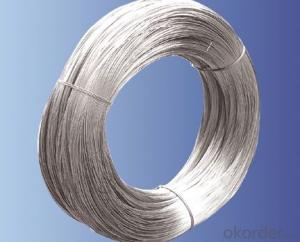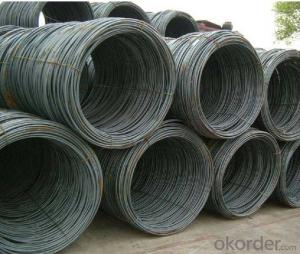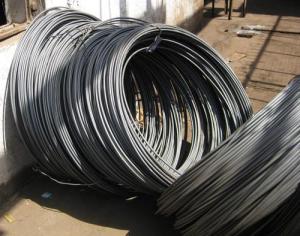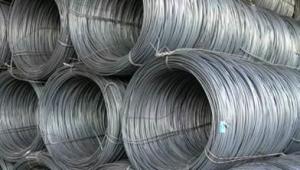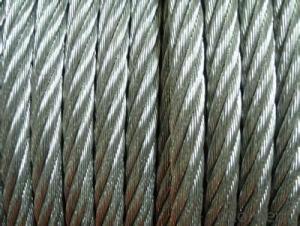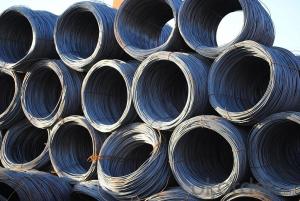Stainless Carbon Steel Wire Rod with Standard ASTM, GB
- Loading Port:
- Tianjin
- Payment Terms:
- TT OR LC
- Min Order Qty:
- 100 m.t.
- Supply Capability:
- 2000 m.t./month
OKorder Service Pledge
OKorder Financial Service
You Might Also Like
Product Description:
OKorder is offering Stainless Carbon Steel Wire Rod with Standard ASTM, GB at great prices with worldwide shipping. Our supplier is a world-class manufacturer of steel, with our products utilized the world over. OKorder annually supplies products to European, North American and Asian markets. We provide quotations within 24 hours of receiving an inquiry and guarantee competitive prices.
Product Applications:
Stainless Carbon Steel Wire Rod with Standard ASTM, GB are ideal for structural applications and are widely used in the construction of buildings and bridges, and the manufacturing, petrochemical, and transportation industries.
Product Advantages:
OKorder's Stainless Carbon Steel Wire Rod with Standard ASTM, GB are durable, strong, and resist corrosion.
Main Product Features:
· Premium quality
· Prompt delivery & seaworthy packing (30 days after receiving deposit)
· Corrosion resistance
· Can be recycled and reused
· Mill test certification
· Professional Service
· Competitive pricing
Specifications of Carbon Steel Wire Rod:
Steel Grade: Q195/235, SAE1006-1018B Standard: ASTM, GB
Diameter: 5.5mm, 6.5mm, 7mm,8mm,9mm,10mm,12mm,14mm
Diameter tolerance: ±0.3mm
Type: in coil, coil weight around 2MT
Technique: Hot Rolled
Place of Origin: China Mainland
Surface: round, no twisted, light and smooth
Chemical Composition: (Please kindly find our chemistry of our material based on Q195、Q235A and Q235B as below for your information)
Trademark | Rank | Chemical composition (quality score) % | |||||
C | Si | Mn | S | P | |||
| ≤ |
| ≤ | ≤ | |||
Q195 |
| 0.06-0.12 | 0.30 | 0.25 | 0.050 | 0.045 | |
Q235 | A | 0.14-0.22 | 0.30 | 0.30-0.65 | 0.050 | 0.045 | |
Q235 | B | 0.12-0.20 | 0.30 | 0.30-0.70 | 0.045 | 0.045 | |
Trademark | Rank | Pulling Test | |||||
Bend PointΔs/Mpa | Tensile Strength | Elongation Ratioδ5% | |||||
Thickness (Diameter) /MM | Thickness (Diameter) /MM | ||||||
≤16 | 16-40 | ≤16 | 16-40 | ||||
≥ | ≥ | ||||||
Q195 |
| 195 | 185 | 315-390 | 33 | 32 | |
Q235 | A | 235 | 225 | 375-500 | 26 | 25 | |
Q235 | B | 235 | 225 | 375-500 | 26 | 25 | |
Usage and Applications of Carbon Steel Wire Rod:
After hot-rolled the products shaped into coil and delivery as finished product, including round, square, rectangular, hexagonal and so on. Since most of the products are round, it is generally called wire rod. Carbon steel wire rod is widely used in construction and manufacturing. Carbon steel wire rod is mainly used for reinforcement of reinforced concrete and welded structure or reprocessed (roberts , nail, etc.) materials, especially used to produce wire drawing, welding electrode, nails, spring, electronic, precise machinery parts and so on.
Packaging & Delivery of Carbon Steel Wire Rod:
Packaging Detail: products are packed in coil, each coil weight around 2 MT, and then shipped by container or bulk vessel
Delivery Detail: within 45 days after received deposit or LC.
Label: to be specified by customer, generally, each bundle has 1-2 labels
Trade terms: FOB, CFR, CIF
Note:
1. Our products are produced according to national standard (GB), if not, supply according to national standards (GB) or agreement as customer required.
2. Other Grade and Standard carbon steel wire rod we can supply:
Grade:H08A, 30MnSi, 62B-82B
Standard: AISI, BS, JIS, DIN
The Minimum Order Quantity of these products is high, and need to be confirmed.
3. We can not only supply carbon steel wire rod; if you need anything about building materials, please contact us.
4. Please send us your detail specifications when inquire. We will reply to you as soon as possible.We sincerely hope we can establish a long stable business relationship.
FAQ:
Q1: Why buy Materials & Equipment from OKorder.com?
A1: All products offered byOKorder.com are carefully selected from China's most reliable manufacturing enterprises. Through its ISO certifications, OKorder.com adheres to the highest standards and a commitment to supply chain safety and customer satisfaction.
Q2: How do we guarantee the quality of our products?
A2: We have established an advanced quality management system which conducts strict quality tests at every step, from raw materials to the final product. At the same time, we provide extensive follow-up service assurances as required.
Q3: How soon can we receive the product after purchase?
A3: Within three days of placing an order, we will begin production. The specific shipping date is dependent upon international and government factors, but is typically 7 to 10 workdays.

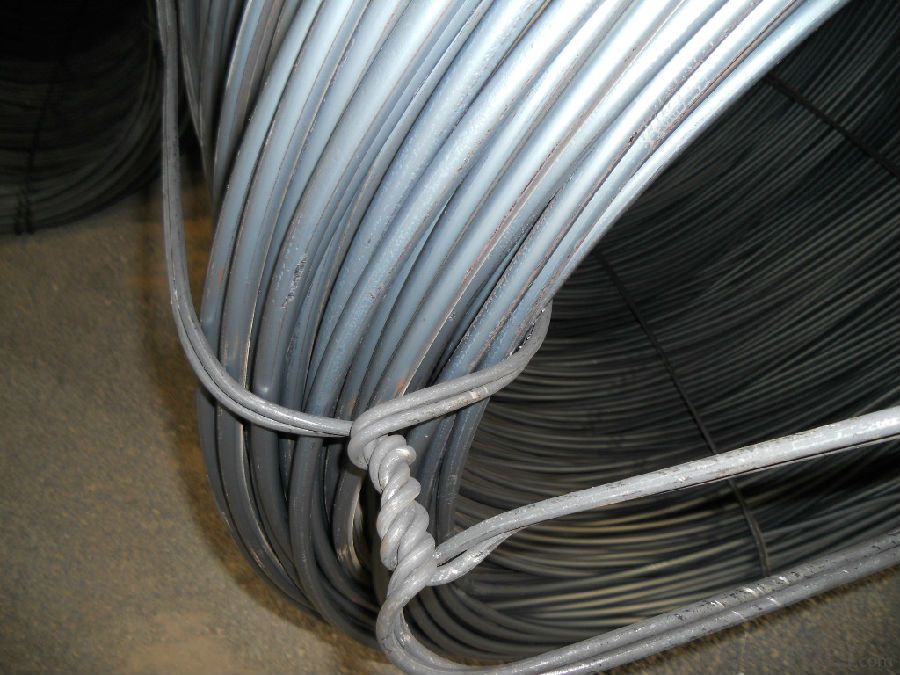
- Q: What are the common applications of high-strength and oil tempered steel wire rod?
- High-strength and oil tempered steel wire rod has a wide range of applications due to its unique properties. Some of the common applications include: 1. Automotive industry: High-strength steel wire rod is used in various automotive components such as suspension springs, engine valve springs, clutch springs, and seat springs. Its high tensile strength and excellent fatigue resistance make it suitable for these demanding applications. 2. Construction industry: Steel wire rod is used in construction applications such as pre-stressed concrete structures, post-tensioning systems, and reinforcement for concrete structures. Its high strength helps in providing structural stability and durability. 3. Manufacturing industry: Steel wire rod is used in the manufacturing of various products like wire ropes, cables, springs, and fasteners. Its high strength and elasticity make it ideal for these applications where flexibility and durability are required. 4. Electrical industry: Steel wire rod is used in the manufacturing of electrical conductors, such as overhead power lines and electrical cables. Its high conductivity and strength enable efficient transmission of electricity over long distances. 5. Agriculture industry: Steel wire rod is used in the manufacturing of fencing materials, barbed wires, and support structures for crops. Its strength and durability help in providing effective protection and support to agricultural fields. 6. Furniture industry: Steel wire rod is used in the manufacturing of furniture items like springs for mattresses and seating arrangements. Its ability to withstand heavy loads and provide comfort makes it a popular choice in the furniture industry. Overall, high-strength and oil tempered steel wire rod find extensive applications in various industries due to their exceptional strength, durability, and flexibility.
- Q: What are the common industry best practices for steel wire rod suppliers?
- Some common industry best practices for steel wire rod suppliers include ensuring quality control throughout the manufacturing process, adhering to international standards and certifications, maintaining efficient production and delivery systems, providing excellent customer service, and continuously improving product offerings and technology.
- Q: What are the main factors influencing the choice of steel wire rod transportation method?
- When it comes to selecting the method of transportation for steel wire rods, several key factors come into play. These factors include distance, cost, time, and safety. Distance plays a pivotal role in determining the most suitable mode of transportation. For shorter distances, trucking or rail transport may be the preferred options. On the other hand, for longer distances, sea or air transport may prove to be more efficient. Cost is another critical consideration as it directly impacts the overall transportation expenses. It is essential to take into account the cost of each transportation method, including fuel, labor, and maintenance. Additionally, the cost of any necessary packaging or handling during transportation should also be factored in. Time is of the essence, particularly for time-sensitive deliveries. Different transportation methods have varying transit times, and the urgency of the delivery may influence the choice of transportation. For instance, air transport is generally the fastest option, while sea transport may take longer but could be more cost-effective. Ensuring the safety of the steel wire rods during transportation is paramount. The chosen transportation method should guarantee the security and integrity of the cargo. Factors such as the susceptibility of steel wire rods to damage, the risk of theft, and the stability of the transportation mode should be carefully considered. For instance, if the steel wire rods are fragile or prone to damage, a transportation method with extra protection, such as containerized shipping, may be preferred. Additional factors that may impact the choice of transportation method include environmental considerations, availability of infrastructure, and the reliability of the selected transportation service provider. Ultimately, the selection of the steel wire rod transportation method should be based on a meticulous evaluation of these various factors to ensure the most efficient, cost-effective, and safe transport of the cargo.
- Q: How is steel wire rod packaged for transportation?
- Steel wire rod is typically packaged in various ways for transportation, depending on the customer's specific requirements and the chosen mode of transportation. One commonly used packaging method involves creating coils by tightly winding the wire rod around a central core. These coils are convenient to handle and transport, and their size and weight can be adjusted according to the customer's needs and the transportation method. To prevent damage during transportation, the coils are often wrapped in protective materials like plastic or paper. Apart from coils, steel wire rod can also be packaged in bundles. These bundles consist of a certain number of individual rods, securely bound together using straps or wire. This packaging is usually preferred for larger quantities of wire rod as it allows for easier handling and loading onto trucks or shipping containers. Bundles are also wrapped with protective material to ensure safe transportation. For international shipping, containers may be necessary. In such cases, the wire rod can be loaded into containers as either coils or bundles, depending on the customer's preference and the efficiency of loading and unloading at the destination. Overall, the packaging of steel wire rod for transportation prioritizes safe and efficient delivery to the customer. Factors such as the quantity of wire rod, the mode of transportation, and the customer's specific requirements are taken into account. By utilizing coils, bundles, or containers, steel wire rod can be securely packaged, minimizing the risk of damage and ensuring its arrival in the desired condition.
- Q: What is the manufacturing process of steel wire rod?
- The manufacturing process of steel wire rod involves several steps. It begins with the melting of iron ore and other materials in a blast furnace. The molten iron is then refined and converted into steel through various processes such as oxygen blowing, electric arc furnaces, or basic oxygen furnaces. Once the steel is produced, it is cast into billets or blooms, which are then hot rolled into wire rod form. The hot rolling process involves passing the billets or blooms through a series of rollers to reduce their thickness and shape them into long, continuous wire rods. After hot rolling, the wire rods are cooled, straightened, and cut into desired lengths. They may undergo additional treatments like surface finishing, heat treatment, or galvanization depending on their intended use. Finally, the wire rods are coiled and packaged for shipment to various industries where they are further processed or used directly in applications such as construction, automotive, or manufacturing.
- Q: How is steel wire rod cut to desired lengths?
- Wire drawing is a common method used to cut steel wire rod into desired lengths. By pulling the steel rod through a series of dies, its diameter gradually decreases. This not only shapes the wire to the desired size but also enhances its strength and flexibility. The wire drawing process can be carried out either manually or with automated machinery, depending on the production scale. Once the wire reaches the desired diameter, it can be cut into specific lengths using various cutting techniques, such as shearing or sawing. These cutting methods can be performed manually or with specialized cutting equipment. In conclusion, the process of cutting steel wire rod to desired lengths involves shaping the wire through wire drawing and then using appropriate cutting methods for precision.
- Q: What are the different heat treatment processes applied to steel wire rod?
- Some of the different heat treatment processes applied to steel wire rod include annealing, quenching and tempering, normalizing, and case hardening. Annealing involves heating the wire rod to a specific temperature and then slowly cooling it to improve its ductility and remove internal stresses. Quenching and tempering involves rapidly cooling the wire rod to increase its hardness and strength, followed by tempering to reduce brittleness. Normalizing is a similar process to annealing, but with a slightly different cooling rate to achieve desired mechanical properties. Case hardening involves adding a thin layer of a harder material to the surface of the wire rod to improve wear resistance.
- Q: How is the chemical composition of steel wire rod analyzed?
- The chemical composition of steel wire rod is typically analyzed using various techniques and methods. One common method is called spectroscopy, which involves the use of instruments such as atomic absorption spectroscopy (AAS) or inductively coupled plasma spectroscopy (ICP). These instruments can accurately determine the presence and concentration of different elements in the steel wire rod. Another technique commonly used is X-ray fluorescence (XRF), which works by bombarding the sample with X-rays and measuring the energy emitted by the elements present in the steel wire rod. This method provides quick and non-destructive analysis of the chemical composition. In addition to spectroscopy and XRF, other methods like optical emission spectroscopy (OES) and mass spectrometry can also be employed for analyzing the chemical composition of steel wire rod. These techniques involve the vaporization and ionization of the sample, followed by the measurement of the resulting ions or emitted photons. It is important to note that these techniques require the steel wire rod to be prepared as a sample, often in the form of a solid or liquid. The sample is usually dissolved, digested, or mixed with appropriate reagents to extract the elements of interest before analysis. Overall, the analysis of the chemical composition of steel wire rod is a crucial step in quality control and ensuring that the material meets the required specifications for its intended use.
- Q: How is steel wire rod used in the manufacturing of wire forms for plumbing systems?
- Steel wire rod is an essential component in the manufacturing of wire forms for plumbing systems. The wire rod is made from high-quality steel, which provides the necessary strength and durability required for plumbing applications. Firstly, the steel wire rod is usually passed through a series of processes, such as heating, rolling, and drawing, to transform it into a wire of the desired diameter and shape. This wire serves as the base material for various wire forms used in plumbing systems. Once the wire is formed, it can be further processed to create different wire forms commonly used in plumbing, such as pipe hangers, brackets, clips, and supports. These wire forms are used to secure and stabilize pipes, ensuring they remain firmly in place. The use of steel wire rod in manufacturing wire forms for plumbing systems offers several advantages. Steel is known for its exceptional strength and rigidity, making it ideal for handling the weight and pressures associated with plumbing installations. Moreover, steel wire rod is resistant to corrosion, which is crucial in plumbing systems where exposure to water and moisture is inevitable. In addition to its strength and corrosion resistance, steel wire rod can be easily bent, shaped, and formed to meet the specific requirements of plumbing systems. This flexibility allows for the creation of custom wire forms that can accommodate unique plumbing layouts and configurations. Overall, steel wire rod plays a vital role in the manufacturing of wire forms for plumbing systems, providing the necessary strength, durability, and versatility required for efficient and reliable plumbing installations.
- Q: How are steel wire rods used in the manufacturing of screws and bolts?
- Screws and bolts rely heavily on steel wire rods as a fundamental component in their production. These wire rods are utilized as the primary raw material from which screws and bolts are derived. To initiate the manufacturing process, careful selection of high-quality steel wire rods is conducted to ensure that they possess the necessary strength and durability characteristics required for screws and bolts. These wire rods are then subjected to a range of procedures, such as heating, rolling, and drawing, in order to transform them into thinner wire forms with precise dimensions. The drawn wire then undergoes a series of additional steps to create the specific shape and thread pattern essential for screws and bolts. For example, the wire may be cut into shorter lengths, and the ends are typically chamfered or beveled to facilitate easier insertion into materials. Once the wire has been shaped and prepared, it progresses to the threading process. This involves the creation of helical ridges on the wire, which will ultimately enable the screw or bolt to securely fasten objects together. The threading can be accomplished using various methods, such as rolling, cutting, or grinding, depending on the desired type of screw or bolt. Following the threading process, the wire is cut into individual pieces of the desired length, and the heads of screws or bolts are formed using diverse techniques, including cold forging or hot forging. Cold forging entails shaping the head by applying pressure to the cold wire, whereas hot forging involves heating the wire before shaping it. After the formation of the heads, the screws and bolts undergo additional procedures, such as heat treatment, surface coating, and quality control inspections. These measures guarantee that the final product meets the required standards for strength, corrosion resistance, and dimensional accuracy. In essence, steel wire rods play an indispensable role in the manufacturing of screws and bolts. They function as the initial material and undergo several processes, encompassing shaping, threading, and forming, to ultimately yield high-quality screws and bolts that find extensive use in numerous industries.
Send your message to us
Stainless Carbon Steel Wire Rod with Standard ASTM, GB
- Loading Port:
- Tianjin
- Payment Terms:
- TT OR LC
- Min Order Qty:
- 100 m.t.
- Supply Capability:
- 2000 m.t./month
OKorder Service Pledge
OKorder Financial Service
Similar products
Hot products
Hot Searches
Related keywords
